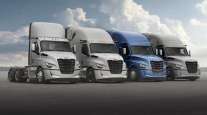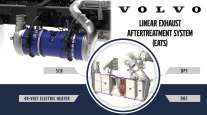Senior Reporter
California Drayage Fleets Face Potential Zero-Emission Mandate

[Stay on top of transportation news: Get TTNews in your inbox.]
The push for zero-emission trucks in California has left drayage operators questioning that approach in light of their previous investments in equipment using natural gas fuel, an industry association executive said.
Under an executive order by Gov. Gavin Newsom, all drayage trucks would be required to be zero-emission by 2035, a move supported by the ports of Los Angeles and Long Beach, Calif.
At the same time, the California Air Resources Board has proposed making it mandatory that in 2023 all new trucks added to the port drayage truck registry be zero emission — which is, to some, another way of saying battery-electric vehicles.
The wording on new drayage trucks “makes me feel that you can read that between the lines, unless there is a zero-emissions natural gas truck I’m unaware of,” Weston LaBar, CEO of the Harbor Trucking Association, told Transport Topics.
CARB should be looking at more than just tailpipe emissions as the indicator of which approach is cleaner, and include the whole emissions life cycle from source to end use, he said.
“CARB wants to phase out all internal combustion engines regardless of fuel source,” LaBar added. “For many of our members, the fastest way, the most immediate way to sustainability is with RNG.”
Advocates of RNG say the fuel can achieve net negative emissions of greenhouse gases by capturing and repurposing methane from existing sources such as food waste and animal manure.
Meanwhile, CARB reported a number of natural gas- and propane-fueled Otto-cycle engine families have been certified to its most stringent optional low NOx standards of 0.02 gram per brake horsepower-hour — a 90% reduction from engines operating at the current U.S. Environmental Protection Agency NOx limit of 0.2 gram.

LaBar
“How can you as a business make massive multimillion [dollar] investments in trucks and fueling stations that just three years ago [under an earlier CARB initiative] we were told were the future,” LaBar said, “only to be told three years later ‘we have changed our mind everything has to plug in.’ That’s not a good business culture.”
Luckily, he said, the trucking industry, in exchange for an increase in the diesel excise tax, secured a useful life provision for existing trucks of 13 years or up to 800,000 miles and a maximum life of 18 years if the mileage is still under 800,000.
“We want to be able to operate in a sustainable manner,” LaBar said, “both environmentally and economically.”
The Harbor Trucking Association is a coalition of about 200 intermodal carriers serving America’s West Coast Ports: Los Angeles, Long Beach, Oakland, Seattle and Tacoma.
Want more news? Listen to today's daily briefing below or go here for more info:





